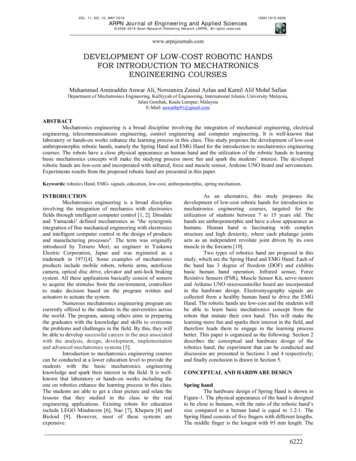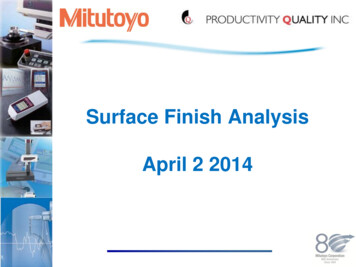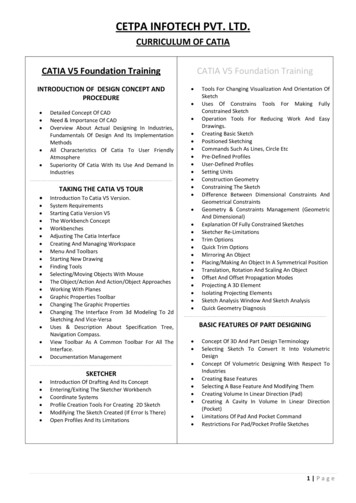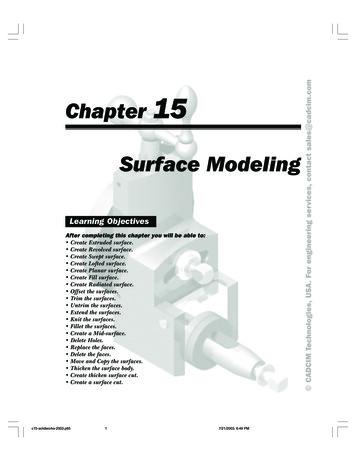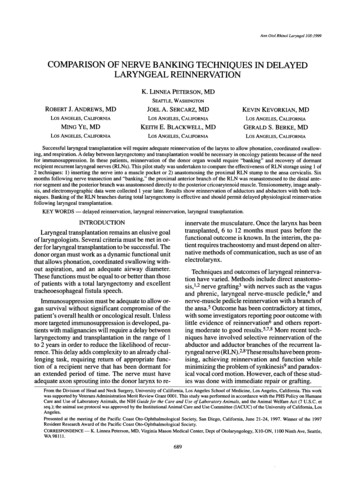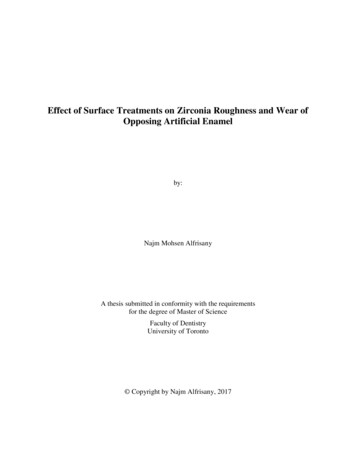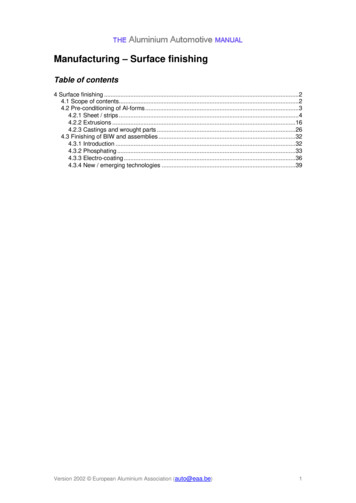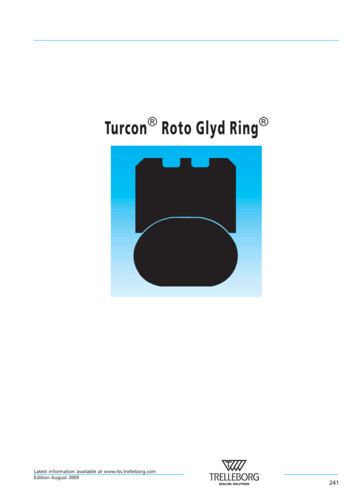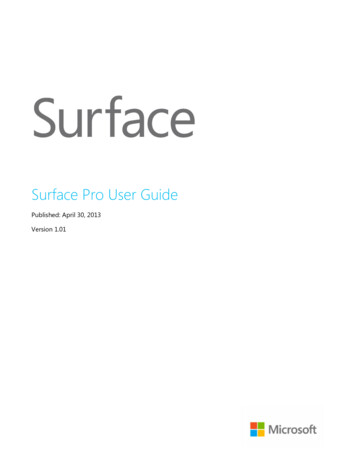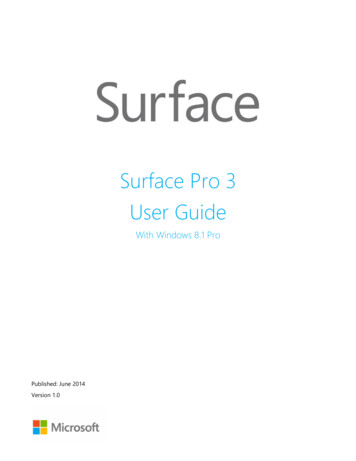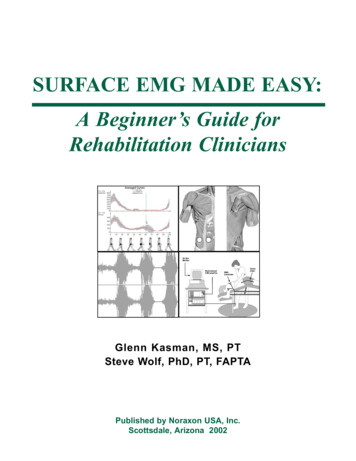
Transcription
SURFACE EMG MADE EASY:A Beginner’s Guide forRehabilitation CliniciansGlenn Kasman, MS, PTSteve Wolf, PhD, PT, FAPTAPublished by Noraxon USA, Inc.Scottsdale, Arizona 2002
Copyright Noraxon U.S.A., Inc. 2002Reproduction without written permission is granted to Physical TherapyPrograms and other educational institutions for educational purposes only. Toorder additional copies of the manual or parts of it contact Noraxon at:1-800-364-8985 or www.noraxon.com
Before you startThe purpose of this manual is to make it easier for clinicians to use SEMGin their practice. The format of the book was chosen to provide a convenient way for instructors in Physical Therapy programs to incorporateSEMG evaluation and rehabilitation methods to relevant parts of theircurriculum. Although it is not necessary to read the book from the beginning to the end, it is suggested that the reader takes a thorough look at thelist of contents before selecting where to start.Chapter 1. Practical considerations for clinicians using SEMG providesmany suggestions for beginning users and should be reviewed by anybody not familiar with the basic concepts. The other chapters are morespecific in their scope and allow the readers to focus on the applicationsclosest to their needs. When reviewing the material for any particularbody region please keep in mind that additional insight can be gained byconsulting both Chapter 3. Regional applications of SEMG to musculoskeletal problems and Chapter 5. Regional applications of SEMG topatients with neuromuscular conditions.All the electrode placement illustrations referenced in the text have beenplaced in the appendix and may be photocopied for personal or educational use. Brief instructions for Noraxon SEMG software and hardwareuse are included in the text and in the appendix. More detailed instructions are available in the User Manuals provided with each system.Noraxon is grateful to the authors for their willingness to share decades ofclinical and teaching experience in SEMG applications. Any suggestionsfrom the readers for future editions of this manual are welcome.Tuula Tyry, Ph.D. (Editor)Dir. Research and EducationNoraxon U.S.A., Inc.
Surface EMG made easy: A Beginner’s Guide for Rehabilitation CliniciansChapter 1:PRACTICAL CONSIDERATIONS FOR CLINICANS USING SEMG 1Clinical Preparation1Underlying Principles 2Patient Briefing 3SEMG Set-up 4Basic Display Options & Recording Principles6Recording Principles 7SEMG, Force, and Fatigue RelationshipsSEMG Feedback Training1015Setting patients up for success 19Data Reporting24Qualitative Assessments 24Quantitative Assessment 27Normalization 28Percent Difference 29Percent of Maximal Voluntary Contraction 31Chapter 2:AN OVERVIEW OF SURFACE ELECTROMYOGRAPHY AND MUSCULOSKELETALDYSFUNCTION 41Musculoskeletal Dysfunction and Muscle ImbalanceHistorical PerspectivesThe Situation Today45Assessment Of Patients Using SEMGSEMG Feedback TrainingConclusionsReferences414447485152Chapter 3:REGIONAL APPLICATIONS OF SEMG TO MUSCULOSKELETAL PROBLEMS 55Temporomandibular region55Case Example 56References60Cervical region63Case Example 64References71NORAXON iii
Shoulder girdle region75Case Example 76References83Low back and Trunk86Case Example 90References97Hip region103Case Example 104References108Knee region109Case Example 112References116Chapter 4:AN OVERVIEW OF SURFACE ELECTROMYOGRAPHY AND NEUROMUSCULARDISORDERS 121Contemporary use of surface EMG with neurological patients 122Contra indications125Chapter 5:REGIONAL APPLICATIONS TO PATIENTS WITH NEUROMUSCULAR CONDITIONS 127Anterior neck region127Upper extremity: general goal1. Shoulder2. Elbow1291301323. Forearm: pronation/supination 1354. Wrist: flexion/extension136Fingers: Flexion and ExtensionThe Thumb (Pollux)139142Lower extremity: general goal1441. Weight shifting / weight bearing2. Gait initiation: hip flexion3. Gait: knee flexion4. Gait: ankle controliv NORAXON149150147144
Surface EMG made easy: A Beginner’s Guide for Rehabilitation CliniciansAPPENDIXThe Physical Interface: Electrode placement IQuick start tutorial XVNORAXON v
vi NORAXON
Laboratory exercises are found on the pages listed below.Lab disclaimer: Students should be cautious not to use subjectswith history of regional pain or problem. Exercises need to be discontinued if the subject experiences any discomfort or difficulty.LAB EXERCISE 1: Patient Briefing 4LAB EXERCISE 2: Electrode attachment and system start-up 6LAB EXERCISE 3: Basic display options 7LAB EXERCISE 4: Fundamental Principles 11LAB EXERCISE 5: Heart and Respiration Artifact 14LAB EXERCISE 6: Basic Feedback Training Techniques 16LAB EXERCISE 7: Combining Uptraining and Downtraining 19LAB EXERCISE 8: Qualitative Assessments with SEMGLAB EXERCISE 9: Normalization 36LAB EXERCISE 10: Temporomandibular Region 58LAB EXERCISE 11: Cervical Region 66LAB EXERCISE 12: Shoulder region 79LAB EXERCISE 13: Low back and trunk region 92LAB EXERCISE 14: Hip region 106LAB EXERCISE 15: Knee 114Case examples of neuromuscular conditions with associated questions and answers begin on page 128.
Chapter 1:PRACTICAL CONSIDERATIONS FOR CLINICIANS USING SEMGThis chapter will explore practical considerations for clinicians using surface electromyography (SEMG) with patients with neurological and musculoskeletal problems. Practitionerswill gain a fundamental appreciation of patient needs, recording technique, system operation,interpretation of the SEMG display, feedback training, and data management. The material issequenced to blend clinical and technical SEMG principles in a time-efficient manner combining narrative review with laboratory exercises.Clinical PreparationPatients may initially be anxious about having SEMG electrodesattached to them as well as curious as to what the SEMG machinedoes and why SEMG procedures are being suggested as part of thecare plan. They likely will not be familiar with the anatomy andfunction of the muscles that are to be recorded. In addition, they maynot intuitively understand the SEMG display or how to interpret cuesduring feedback training. Outcomes may be enhanced by performance of some preliminary steps to SEMG monitoring and feedbacktraining.PRACTICAL CONSIDERATIONS 1
Clinical PreparationUnderlying Principles1. Begin SEMG monitoring after you have performed a thoroughintake and physical examination as appropriate to the case at-hand.2. Identify impairments, functional limitations, and disabilities as wellas relevant pathophysiological processes, if known.3. Establish a working hypothesis as to the underlying key problemsand the potential role of impairments related to muscle activity.4. Consider SEMG assessment if: There is a reasonable probability that neuromuscular impairmentscontribute significantly to the patient’s problems, which are unlikelyto resolve spontaneously. Information regarding muscle activity is likely to influence theintervention plan. SEMG recordings can be performed in a cost-effective manner.5. Following SEMG assessment, integrate the results with the otherexamination findings and determine a movement system diagnosis,prognosis, and intervention plan.6. Consider SEMG feedback training if aberrant patterns of muscleactivity are identified that may be amenable to change through motorlearning by the patient.7. Consider use of SEMG to evaluate the effects of other interventionsdesigned to impact muscle activity (such as therapeutic exercise prescription, orthotics, modalities, and manual therapy techniques) or tointegrate SEMG training within the context of other therapeutic exercise interventions.2 NORAXON : SURFACE EMG MADE EASY
Clinical PreparationPatient Briefing1. Briefly explain the rationale and goals for SEMG assessment andfeedback training in terms appropriate to the patient’s level of understanding.2. Briefly explain the operation of the SEMG device.3. Explain to the patient what he or she can expect to feel and do during the session.Example Remarks to Patient“When you move, your brain sends off a series of commands that godown the spinal cord and out over nerves to muscles. Muscles do whatthe brain tells them to do. The brain sends these signals in the form oftiny electrical impulses – your body activates muscles with its own tinyelectrical system. The equipment measures your body’s own electricalimpulses as they spread from the nerve over the surface of the muscle.The device shows how strong your body’s signals are at the displayscreen – so we, you as well as me, can see how well the muscles arebeing activated. The equipment is very sensitive and can pick up lowlevels of muscle activity that we might not be able to see or that youmight not feel.We’ll be able to take some of the guesswork out of assessing your muscle function and judge if your muscles are too active, not active enough,or whether one muscle is working together with other muscles the waythat it should. I’ll be monitoring the results closely and put the information together with our other examination procedures. If I see a pattern of muscle activity that could be significant, I’ll explain it to youand we may choose to have you watch the display and try some different things to improve the pattern. By watching the screen, you’ll beable to get a better sense of how your muscles are being activated andyou may be able to learn ways to activate (or relax) your muscles moreeffectively.PRACTICAL CONSIDERATIONS 3
Clinical PreparationYou’ll feel sensors attached to your skin. They will feel like pieces oftape. There are no needles or electric shocks. The machine will not doanything to you. You won’t feel anything from the machine except thesensors touching your skin.After the sensors are attached, we’ll try some different movements andsee how exactly your muscles respond. I may guide you to performsome special exercises, change your posture, or experiment with different movement patterns.Do you have any questions or concerns? Shall we proceed?”LABORATORY EXERCISE 1: Patient Briefing Select a partner and role play a patient-therapist initial SEMG sess-sion. Assume any neurologic or musculoskeletal diagnosis desired (e.g.hemiparesis following cerebral vascular accident, chronic neck pain,shoulder impingement syndrome). Explain the rationale and goals for SEMG assessment and feedbacktraining, operation of the SMEG device and what the patient shouldexpect to feel and do during the session. Ask your partner to provide feedback regarding the clarity of yourexplanation.SEMG Set-up1. Begin in the clinic in a non-distracting environment.2. Position the patient with appropriate postural support, so that theinvolved body region is visible.4 NORAXON : SURFACE EMG MADE EASY
Clinical Preparation3. Explain what you are doing as you attach electrodes and get the system ready for operation.4. To avoid potentially uncomfortable manual pressure, attach electrodes to the lead wires before you place them on the patient.5. Prepare the skin by rubbing vigorously with an alcohol swab or ifpreferred, a moistened abrasive paper towel.6. Attach the reference electrode first and then place the recordingelectrodes in the desired locations, pressing down around each adhesivecollar with your fingers to ensure good contacts.7. Initiate monitoring, calibrate, and verify an active signal from thetarget muscle. Observe: An appropriate baseline signal. Increased signal amplitude when the patient performs the action ofthe target muscle.Example Remarks to Patient“I’m going to rub your skin with alcohol over the sites that we’ll bemonitoring to help get the best quality signal. You’ll feel me rubbingvigorously and it will be cool. After that, I’m going to attach the sensors and I’ll be making adjustments to the machine so that we are readyto go.”Once the electrodes are attached and the system on-line, direct thepatient to perform the action of the target muscle:“Note how the display goes up when you move and activate the muscle. When you relax, the signal goes down toward the bottom. Theheight of the signal is proportionate to the level of activity in your muscle.”PRACTICAL CONSIDERATIONS 5
Basic Display Options & Recording PrinciplesLABORATORY EXERCISE 2: Electrode attachment and system start-up Prepare the skin for recording over your subject’s biceps. Attach an electrode to the reference lead (black) and two electrodes to the recording leads for channel 1 and channel 2. Peel the backingfrom the electrodes, apply the reference electrode over the C7spinous process.Apply the recording electrode pair for channel 1 as close together aspossible without touching, parallel to muscle fiber direction, overthe center of biceps.Apply the recording electrode pair for channel 2 proximal and distalto those of channel 1, as shown in FIGURE 19.Start the system and go to measurement screen (See appendix fordetails). Click on the global calibration button (yellow ruler in thetop left corner of the screen) to adjust the baseline to zero.Ask the subject to flex his or her elbow several times. Observe anincrease in signal amplitude with contraction and decrease in signalamplitude with relaxation.Basic Display Options & Recording PrinciplesThe SEMG display can be manipulated for optimal observation of muscle activity. Increasing the speed of the screen sweep will facilitateassessment of the timing of muscle activation and deactivation whereasslowing the sweep speed will enable capture of multiple movement trials on a single screen width. By adjusting the amplitude scale, low orhigh levels of activity can be fully visualized. After tracings arerecorded and saved, the amplitude scales can again be adjusted, othersimple statistics obtained quickly, and one tracing superimposed onanother to compare activity relationships across channels. In addition,powerful reports can be generated to document activity patterns andquantify various comparisons of clinical interest.6 NORAXON : SURFACE EMG MADE EASY
Basic Display Options & Recording PrinciplesLABORATORY EXERCISE 3: Basic display options Follow the instructions in Lab 2 and go to measurement screen. Press the S-key (slow) and the F-key (fast) on the keyboard to adjust the sweep speed. With slower speed more of the tracing will fit onone screen, allowing you to keep track of what has happened. Fasterspeed allows for more details to be traced and is more appropriatefor ballistic movements (e.g. golf swing). Note: this is just a displayfeature and does not affect the actual data collection at all.Press the PgUp (Page Up) and PgDn (Page Down) keys on the keyboard. The amplitude scaling for all channels will change in 10%increments of the original scale (e.g. 50 uV if you started with ascale of 500 uV). You can change the scaling of individual channelswith the up and down arrows next to each channel. Note: this is justa display feature and does not affect the actual data collection at all.Click on the Freeze button to review the tracing and on Continue tocontinue monitoring.Click on the Store button to start recording. The tracing turns red andthe test time in the right upper corner starts running. Click on thePause button to return to monitoring mode. Notice that the tracingis white and the running time stops. You can continue recording inthe same file by clicking on the Continue button. Note: a vertical redline in the data file will indicate that the Pause or Freeze functionwas used although the line is not visible in real time.Click on Exit button when you are done and click on No when askedif you want to save the data.Recording PrinciplesThe amplitude of the SEMG signal varies as a function of: Electrode placement – for a large superficial muscle, electrodesshould generally be placed over the center of the muscle belly. ForPRACTICAL CONSIDERATIONS 7
Basic Display Options & Recording Principles small muscles, electrodes may be placed over the target muscle asfar as possible from other muscles that might contaminate the signal.Electrode size – the larger the electrode, the lower the impedance atthe detection zone and the greater the SEMG amplitude.Interelectrode distance – the wider the spacing between active electrodes, the broader and deeper the pick-up, and the greater theSEMG amplitude.Orientation of recording electrodes – most often, the recording electrodes should be positioned parallel to muscle fiber direction. Parallel orientations tend to result in more specific muscle recordings.Skin impedance – the greater the impedance at the skin-electrodeinterface, the greater and more unstable the baseline (resting) SEMGamplitude, and the less accurate the SEMG tracing during movement.Muscle depth and subcutaneous adipose – the more superficial themuscle and the lesser the amount of subcutaneous adipose, thegreater the SEMG amplitude.Contraction intensity – the higher the recruitment level of motorunits, the higher the SEMG amplitude.Contraction velocity – the greater the movement acceleration, thehigher the SEMG amplitude.Contraction type or phase – for example, for an equivalent load,velocity, and movement arc in a healthy subject, the SEMG amplitude will always be higher during the concentric phase of movementcompared to the eccentric phase.In addition, SEMG tracings may be affected by: Muscle geometry as well as proportionate amounts and distributionof fiber types. Normal segmental and suprasegmental neurophysiological reflexes. Pathological central or peripheral nervous system lesions, myopathic disease.8 NORAXON : SURFACE EMG MADE EASY
Basic Display Options & Recording Principles Cognition and emotions related to pain and disability. Motor skill and conditioning levels. “Cross talk” from other muscles, heart artifact, respiratory artifact,movement artifact; electromagnetic radiation from fluorescentlights, electric motors, video monitors and other types of electronicequipment; and on rare occasions, radio transmissions. Signal processing hardware and software unique to each manufacturer’s engineering design.Single-use, disposable electrodes are recommended for ease of application and signal quality.Care should be taken to use a consistent load, range of motion arc, andvelocity when results will be compared across multiple movement trials. Use of a metronome is a simple way to regulate the pacing ofmovement.Obviously, some of the above factors can be controlled by the operatoror modulated by the subject and others cannot. The susceptibility ofthe recordings to some forms of noise and artifact may vary with thequality of the SEMG system as well as certain control features of thesystem hardware and software. Adhering to the basic principles ofrecording technique described in this manual will minimize most problems. Thus, for isolated SEMG recordings, the following should beused: Relatively smaller electrodes - 0.8 cm diameter circular electrodesor smaller; or bar-shaped electrodes of comparable or smaller surface area. Close inter-electrode distance – 2.0 cm, or less, measured from thecenter of one electrode to the center of the other. Recording electrode orientation parallel to muscle fiber direction. Careful placement over the target muscle, away from potentiallycontaminating muscles.PRACTICAL CONSIDERATIONS 9
SEMG, Force, and Fatigue RelationshipsSometimes, cross talk from neighboring muscles will be unavoidable.It is somewhat easier to rule cross talk out than to rule it in. Signalfrom the target muscle can be confirmed by asking the patient to perform the action of that muscle and observing a response at the displayscreen (e.g., elbow flexion for biceps). If, then, the patient clearly performs the action of neighboring muscles and there is no response in thesignal for the target channel (e.g., no response from the “biceps” channel during obvious triceps contraction), cross talk is not an issue. If,however, a response from the target channel is observed during contraction of a neighboring muscle (e.g., increased biceps SEMG amplitude during triceps contraction), it is uncertain to what extent theactivity seen from the target channel is due to cross-talk versus co-activation of the target muscle. Usually the magnitude of the response fromneighboring muscles needs to be reasonably “noticeable” for its effectsto truly “contaminate” the results.SEMG, Force, and Fatigue RelationshipsThere tends to be a directly proportional relationship between SEMGamplitude and force under isometric, non-fatiguing conditions. As theintensity of contraction increases, both the SEMG amplitude and forceincrease in a predictable and linear manner. However, this relationshipdoes not hold under dynamic conditions. The relationship between theSEMG amplitude and force will be unknown in the clinic. In additionto the complex effects of the variables listed in the previous section,SEMG amplitude and force production may be differentially affectedby changes in joint angle and consequent alterations in muscle lengthtension relationships and angle of tendon insertion. Fatigue may alsoaffect the SEMG-force relationship. The SEMG device measures voltage, which when properly recorded, represents the relative level ofinstantaneous muscle recruitment but not force. A muscle may be saidto be more or less active as the SEMG amplitude increases ordecreases, respectively, but under dynamic conditions, inferences can-10 NORAXON : SURFACE EMG MADE EASY
SEMG, Force, and Fatigue Relationshipsnot be drawn about resultant forces unless dynometric measurementsare made also.Intuitively, one might expect the SEMG amplitude to decline progressively with fatigue. Although the SEMG amplitude will eventuallydecrease with fatigue, the onset of fatigue cannot be reliably determined solely by observing an amplitude tracing. In fact, if fatigue isdefined as the loss of the ability to sustain a constant force level, theSEMG amplitude may typically remain steady or increase at fatigueonset. Fatigue relationships may be studied profitably by examiningshifts in the frequency content of the SEMG signal, an advanced topicthat is introduced later in this chapter (see page 13).Thus, the SEMG amplitude is not itself an indicator of force, strength,or fatigue. However, when properly performed, analysis of the SEMGamplitude is a reliable and valid tool for qualitative and quantitativeobservations of recruitment intensity as well as the timing of muscleactivation and deactivation.LABORATORY EXERCISE 4: Fundamental PrinciplesUse the set-up described in Laboratory Exercise 3: Basic DisplayOptions for the following exercise. For each task, remember to adjustthe amplitude scale to optimally visualize the level of muscle activity. Tap on the electrodes. Jiggle the lead wires. Do you observe move-ment artifact? How could you minimize the effects of movementartifact? Unsnap one of the active electrodes (you will not harm the subjectnor the machine). What happens to the SEMG display for that channel? This is also the way the display typically appears if an electrode pulls lose or otherwise makes faulty contact – a commonproblem to be aware of. Ask the subject to perform several repetitions of active elbow flexion. Which channel shows the greater amplitude, the channel withPRACTICAL CONSIDERATIONS 11
SEMG, Force, and Fatigue Relationships the narrower active electrode placement or the channel with thewider active electrode placement? Why?Provide gentle resistance as the subjects performs a modest elbowextensor contraction. Which channel shows the greater amplitude,the channel with the narrower active electrode placement or thechannel with the wider active electrode placement? Why?NOTE: see the appendix for instructions if you want to record themeasurement rather than simply observe the signal in the monitoringmode as before.Focus on the display from Channel 1 and ask the subject to performseveral repetitions of elbow flexion/extension against gravity at amoderate rate. Observe the concentric versus eccentric phases ofmovement. Which phase is associated with higher SEMG amplitude? Is this what you would expect? Which phase would be associated with greater peak torque if maximal resistance were applied tothe movement? How can you explain the results?Ask the subject to flex the elbow rapidly and then very slowly.Which trial results in greater SEMG amplitude? Which trial wouldresult in greater peak torque if maximal resistance were applied during the movements? How can you explain the results?Manually muscle test the subject’s maximal voluntary effort forresisted elbow flexion. Perform three contractions, about 6 secondseach and separated by at least 30 seconds of rest (do not perform thisexercise if the subject has neck or shoulder pain or otherwise mightbe injured). Test isometrically with the limb positioned in the shortened range, mid-range, and the lengthened range. Which position isassociated with the greatest SEMG amplitude? Repeat testing if youneed to confirm the results. Which position would you expect to beassociated with the greatest peak torque? It should be apparent nowthat the SEMG amplitude cannot be equated with force.Maximally resist the subject through several repetitions of a functional task, such as feeding. Does the value for peak biceps activation change? If so, why?Add quick stretches during the task. Does the value for peak bicepsactivation change? If so, why?12 NORAXON : SURFACE EMG MADE EASY
SEMG, Force, and Fatigue Relationships Perform several tapping repetitions over the bicipital tendon, as ifyou were testing the biceps reflex. Change the amplitude scale sothat you are able to clearly visualize deflection of the SEMG signalwith each tap. What two things might be responsible for the transient increase in amplitude that accompanies each tap? Is there anything you could do to distinguish between the two effects?Optional fatigue test: Use Escape to exit the measurement screen or End to get out of therecord viewer screen. Click on Back to return to the MyoClinicalentry screen. Choose Clinical Frequency Protocols and click onNext. Type in a file name such as fatigue and click on Measure.Click on the yellow Calibration button. Ask the subject to assume a seated position with elbow flexed about90 degrees. Stand above the subject’s arm and resist maximal effortelbow flexion until fatigue clearly results and/or the subject wishesto stop (may require 1-2 minutes of effort). Encourage the subject tosustain maximal effort throughout the activity. Make sure to click onStore as soon as the contraction starts (the tracing turns red to indicate that it is being recorded). After 1-2 minutes click on Exit to endthe recording and Yes to save it. Watch the SEMG amplitude carefully during the contraction. Does the SEMG amplitude increase,decrease, or remain relatively flat at the onset of observable fatigue?Can you explain the results? Follow the instructions on the Record Viewer screen prompting youto place two markers (vertical white lines) by double clicking in thebeginning and at the end of the EMG tracing. (You can leave out thevery beginning of the recording if it includes the ramp of getting tothe maximum level). Click on Continue. The bars in the two graphsrepresent 2 second time intervals through out the 1-2 minute test.Compare what happens to the SEMG amplitude versus the medianfrequency during the contraction. You should note a relativelysteady decline in the median frequency from the start of contraction.The median frequency declines in a reliable way during sustained,high intensity isometric contractions and can be used to quantify thePRACTICAL CONSIDERATIONS 13
SEMG, Force, and Fatigue Relationshipseffects of fatigue. In clinical situations, the SEMG amplitude doesnot change in a predictable way at the onset of fatigue and shouldnot be used to define fatigue relationships.At the end of the lab exercise: Remove the electrodes for Channel 1. Support the skin with onehand while gently peeling off the electrode with the other, peeling inthe direction of any hairs. Spread a thin layer of conductive gel overthe recording area (use a dab of electrical stimulation gel or try tosmear some gel from the electrodes if using a electrodes with lowviscosity gel). Reapply the Channel 1 electrodes (use new electrodes if necessary. Tape may be required to hold the electrodes inplace. Instruct the subject to perform several repetitions of elbowflexion as well as isometrically resisted elbow flexion. Does theSEMG amplitude appear different than before? Why?LABORATORY EXERCISE 5: Heart and Respiration Artifact Prepare the skin for recording over the left and right crest of the upper trapezius (FIGURE 5) and also over the C7 spinous process.Apply one of the single electrodes for Channel 1 over the center ofthe crest of the left and the other on the right upper trapezius. Placethe single reference electrode over the C7 spinous process.Ask the subject to shrug his or her shoulders several times. Observean increase in signal amplitude with shoulder shrug and decrease insignal amplitude with release.Instruct the subject to sit quietly and look for the presence of heartartifact as a series of transient spikes or bumps in the baseline.Monitor the subject’s pulse and assess if the palpable pulse rate corresponds to the deflections of the SEMG amplitude. What could youdo to reduce the heart artifact?Remove the recording electrode from the right upper trapezius.Attach a new electrode and apply it as close as possible to the14 NORAXON : SURFACE EMG MADE EASY
SEMG Feedback Trainingrecording electrode over the left upper trapezius, just so the twoelectrodes do not touch if using solid gel electrodes. (Wet gel electrodes have an adhesive area around the conductive gel and will notshort even when the edges are touching.) What happens to theamplitude of the recorded heart artifact? Heart artifact is “crosstalk” from the heart, similar to the issue of volume con
4NORAXON: SURFACE EMG MADE EASY You'll feel sensors attached to your skin. They will feel like pieces of tape. There are no needles or elect ric shocks. The machine will not do anything to you. You won't feel anything from the machine except the sensors touching your skin. After the sensors are attached, we'll try some different movements and
